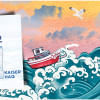'Small World City' Issue 04: Another dosage of the beautiful and the haunted

From its very inception, Small World City (SWC) set out with a goal of creating a space for otherworldly speculative fiction—stories brimming with the absurd, the otherworldly, and the mystical. With every subsequent issue, the stories presented have delved deeper into the very idea of what a literary journal dedicated to speculative fiction can offer. Of course, that's only one part of everything found in the fourth issue of SWC.
The latest offering from the online literary journal feels, in many respects, like their most polished work yet. I have always been fond of the visual aesthetic that so starkly sets them apart—and with every issue, I find myself awed at the world the editors and artists have managed to create just on their website. Every visit is a journey. And every story, every essay, every poem, serves as a concentrated dosage of something visceral and, as the journal itself claims, otherworldly.
For starters, the fiction segment boasts a slew of stories that vary a fair bit in their content and theme, but the speculative nature of the storytelling allows these authors to go all out—and we see it from the very first story, "Immutable March Down the Tracks of Limbo" by Adia Reynolds. Set entirely in a train featuring only two conscious characters and an entire train filled with passengers who never quite make it to being fully awake—there are several praiseworthy elements in the story. The horror of the setting is elevated wonderfully by the prose, and although the dialogue may feel clunky at parts, there is no denying the sinister atmosphere that creeps into a climax that is at once raucous and chilling.
In Ziaul Moid Khan's "The Intellectual Theft", we see a story focused on concepts of black magic and Islamic mysticism. The presentation here is, once again, fascinating, as we follow Abdul and Balraj in their attempts at book theft against Aapa-Bi, with a fantastical twist that ends in tragedy. The mystical aspects of the story came out of the blue—and part of me wishes it played a more active role for longer than it did—but that could also be indicative of how engrossing the world felt to read.
On the topic of worlds that feel fully fleshed out, the fiction section's highlight, to me, is undoubtedly "The Astrolorist of Zumar Valley". Madeeha Reza creates what is perhaps the most organic feeling world I have read from SWC's entire catalogue. The concept of Astrolofolklorists trying to decipher the folklore that exists among cultures in the stars is completely unique to me, and the presentation is genius. The narrative, despite a lacklustre ending, moves at an incredible pace, and the characters feel delightfully well-realised—to the point where part of me wishes for a continuation of what has been presented.
And while all the fiction has been a joy to go through, that isn't all that is being offered in Issue 04. We have two major sections to go through, the first of which being the nonfiction part, where creative nonfiction as well as essays of all kinds find their home. For Issue 04, what caught my eye were the two pieces by Rusafa Rahat and SWC's own editor, Mehrul Bari. Rusafa's piece focuses on the history of Marilyn Monroe, and offers a look into the celebrity that is beyond the usual image presented to us by the media. It challenges the caricature pop culture has made out of her, and sheds light on an aspect of her rarely discussed—her skill with words.
Mehrul Bari, on the other hand, presents us with a piece of creative nonfiction that is at once cryptic and hypnotic. The nature of the piece blurs the line between fiction and nonfiction, and it sandwiches itself rather neatly between everything else offered in the nonfiction category.
Finally, there is the poetry section—which is perhaps the best offering of Issue 04. There are numerous standouts. From Snata Basu's "Moving In" and the way she writes about the passage of time as something crushing and yet represented only by the minutiae of daily life, to Vitoria Pérez's "download.scythe_program:revolucionaria!" and its extraordinary experimentation with form and imagery—the collection of poetry in this volume covers the length and breadth of what poetry can look like.
The standout, by and large, is Tashfia Ahmed's "Meeting Virginia Woolf By the Acheron's Stream". The poem mixes the myth of the Acheron River from Greek Mythology with the very real story of Virginia Woolf's suicide by drowning. The result of this juxtaposition is magnificent, and the imagery in display coupled with the poem's own narrative creates layers upon layers to dig through—in many ways, this is poetry at its most potent.
The mix, created by multidisciplinary artist Saraf, acts as the perfect musical companion for journeying through the myriad mystical stories presented alongside the often bizarre, and always otherworldly art throughout the website. Small World City provides a holistic experience, and Issue 04, in that regard, succeeds with flying colours.
Raian Abedin is a poet, a student of Biochemistry, and a contributor for The Daily Star.

 For all latest news, follow The Daily Star's Google News channel.
For all latest news, follow The Daily Star's Google News channel. 







Comments